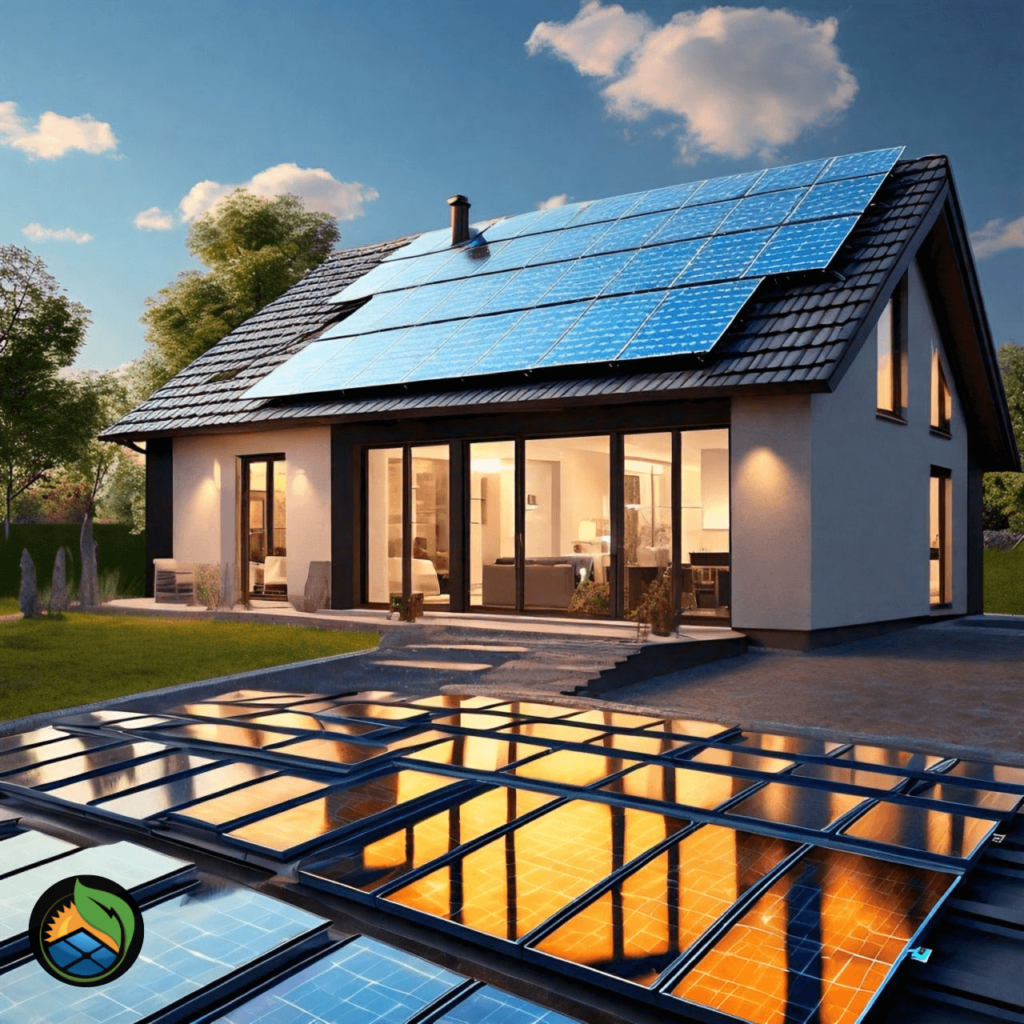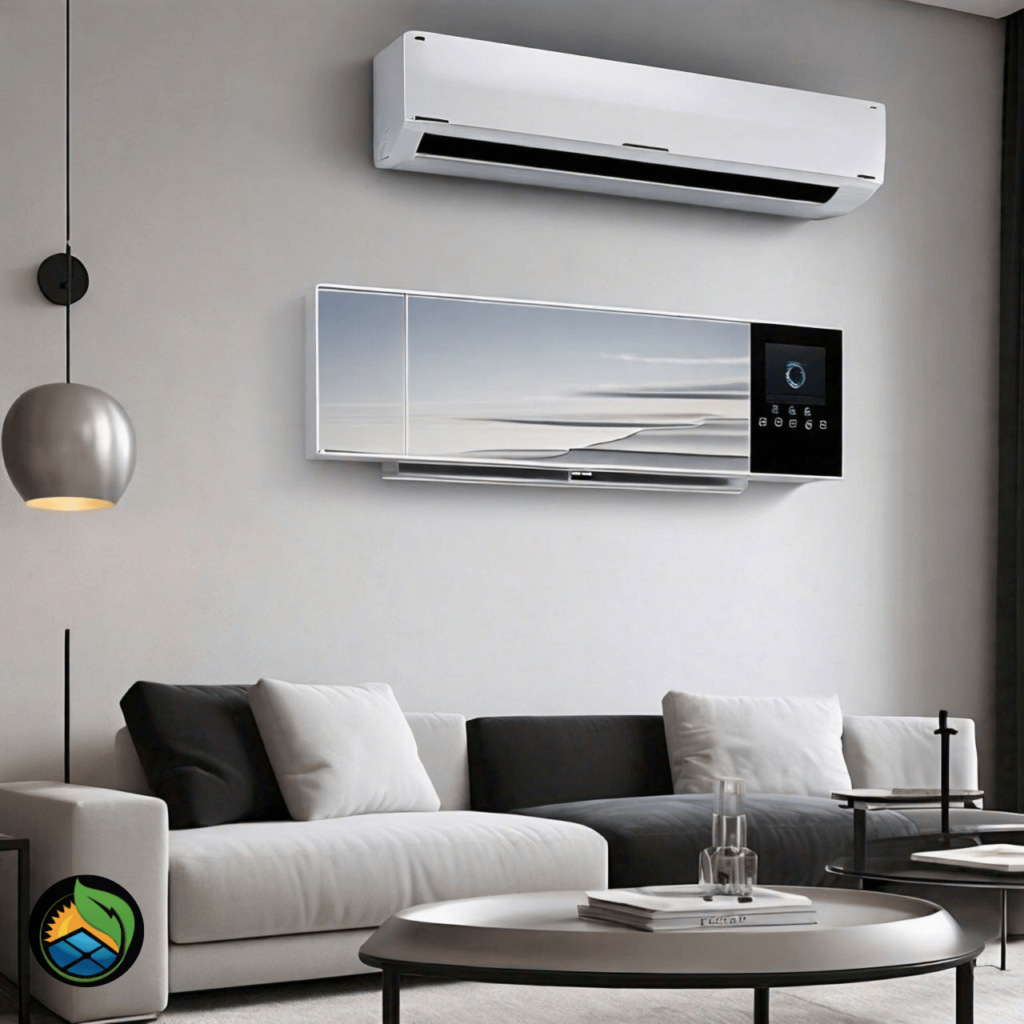Introduction
This blog post will guide you through the intricacies of determining the right number of solar panels, taking into account the power consumption of a 1-ton DC inverter AC, the efficiency of solar panels, geographic and seasonal variations, and the importance of battery storage.
Harnessing the power of the sun to run household appliances is becoming increasingly popular as technology advances and the need for sustainable energy solutions grows. One of the most common inquiries from homeowners considering solar energy is, “How many solar panels are required to power a 1-ton DC inverter AC?” Understanding this calculation is crucial for designing an efficient and cost-effective solar system.
Overview of Solar Panels and DC Inverter ACs
Solar panels are a pivotal component in the renewable energy landscape, converting sunlight into electricity through photovoltaic cells. These panels have revolutionized energy consumption, enabling homes and businesses to harness solar power and reduce dependence on conventional energy sources. On the other hand, DC inverter air conditioners (ACs) represent a significant advancement in cooling technology. Unlike traditional ACs, DC inverters can adjust their speed and cargo according to the cooling demand, enhancing energy efficiency and reducing power consumption.
Importance of Calculating Solar Panel Requirements
Accurately calculating the solar panels required to power a 1-ton DC inverter AC is crucial for ensuring the solar system is sized correctly to handle the load. This calculation involves understanding the AC unit’s power consumption, the efficiency of the solar panels, and various environmental factors that affect solar energy production. A well-sized solar system ensures uninterrupted cooling without reliance on grid power, leading to substantial cost savings and a reduction in carbon footprint.
Understanding the Power Consumption of a 1-Ton DC Inverter AC
Power Rating of a 1-Ton DC Inverter AC
A 1-ton DC inverter AC typically has a cooling capacity of 12,000 British Thermal Units (BTUs) per hour. The power consumption of these units can vary significantly based on factors such as the temperature setpoint, ambient temperature, and operating conditions. On average, a 1-ton DC inverter AC consumes between 800 to 1,500 watts per hour, with higher efficiency models leaning towards the lower end of this range. The ability of DC inverter ACs to modulate their compressor speed according to the cooling demand contributes to their lower power consumption compared to traditional ACs, which operate at total capacity even when the cooling demand is low.
Average Energy Consumption
To estimate the energy consumption of a 1-ton DC inverter AC, it is useful to consider its operation over a typical day. Assuming the AC runs for about 8 hours a day at an average power consumption of 1,200 watts (or 1.2 kW), the daily energy consumption can be calculated as follows:
1.2 kW×8 hours=9.6 kWh/day
Extrapolating this to an annual basis, the energy consumption would be:
9.6 kWh/day×365 days=3,504 kWh/year
This estimate provides a foundational understanding of the energy requirements needed to run the AC and is critical for determining the number of solar panels required to generate sufficient power.
Factors Affecting Solar Panel Requirements
Efficiency of the Solar Panels

The efficiency of solar panels is a critical factor in determining how much power they can generate. Solar panel efficiency refers to the percentage of sunlight the panel can convert into usable electricity. Higher efficiency panels produce more energy per unit area, which can be particularly beneficial in locations with limited roof space. For instance, a solar panel with an efficiency of 20% converts 20% of the sunlight it receives into electrical energy. This efficiency can vary based on the technology used, with monocrystalline panels typically offering higher efficiencies than polycrystalline or thin-film panels.
Peak Sunlight Hours
Peak sunlight hours are the average number of hours per day when the sunlight is strong enough to generate significant amounts of power from solar panels. This measure varies by location and is influenced by factors such as latitude, weather patterns, and seasonal changes. For example, most parts of the United States receive between 4 and 6 peak sunlight hours per day. Understanding the average peak sunlight hours in a specific location is essential for accurately calculating the energy production potential of solar panels.
Geographic Location
The geographic location of a solar installation plays a crucial role in determining its energy production capabilities. Areas closer to the equator receive more consistent and intense sunlight throughout the year than regions farther north or south. Altitude, local climate, and shading from nearby structures or vegetation also affect solar energy production. By considering these geographic factors, one can better estimate the number of solar panels required to meet the energy needs of a 1-ton DC inverter AC.
Seasonal Variations
Seasonal variations significantly impact solar energy production due to changes in sunlight intensity and duration. During winter, shorter daylight hours and lower sun angles result in reduced solar energy generation compared to summer, when days are longer, and the sun is higher in the sky. These seasonal variations must be accounted for in the sizing of a solar system to ensure that it can meet energy demands year-round, even during periods of lower sunlight availability.
Calculating the Number of Solar Panels Needed
Step-by-Step Calculation

To determine the number of solar panels required to power a 1-ton DC inverter AC, we need to consider the total daily energy consumption of the AC and the energy production capacity of one solar panel. Assuming we use standard 300-watt solar panels and an average of 5 peak sunlight hours per day, the daily energy production of one panel can be calculated as follows:
300 watts×5 hours=1,500 watt-hours/day or 1.5 kWh/day
This value represents the amount of energy a single solar panel can generate in a day under optimal conditions.
Example Calculation
Using the previously estimated daily energy consumption of 9.6 kWh for the AC, we can calculate the number of solar panels required:
1.5 kWh/panel/day9.6 kWh/day=6.4 panels
Since we cannot have a fraction of a panel, we round up to 7 panels to ensure that the energy needs are met.
Adjustments for Efficiency and Losses
In practice, it is important to account for inefficiencies and losses due to factors such as shading, dust accumulation on panels, and system inefficiencies (e.g., inverter losses). A common adjustment factor is to multiply the calculated number of panels by 1.2 to 1.3 to ensure a buffer for these losses:
7 panels×1.3=9.1 panels
Rounding up, we might need approximately 10 panels to ensure reliable power generation and account for potential inefficiencies and losses.
Battery Storage Considerations
Need for Battery Storage
Incorporating battery storage into the solar system is essential to maintaining AC operation during non-sunny hours or at night. Batteries store excess solar energy generated during the day when solar panels do not produce electricity. This ensures the AC can operate continuously without interruption, even when sunlight is unavailable.
Battery Capacity Calculation
The required battery capacity depends on the energy needed and the desired autonomy, which refers to the number of hours or days the battery should last without solar input. For instance, to run the AC for a single night (8 hours) with an average power consumption of 1.2 kW:
1.2 kW×8 hours=9.6 kWh
Considering a typical battery depth of discharge (DoD) of 80%, which ensures the longevity of the battery, the actual battery capacity needed would be:
0.89.6 kWh=12 kWh
This calculation helps in selecting the appropriate battery size to support the AC operation during periods without solar generation.
Additional Equipment and Costs
Inverters and Charge Controllers
A solar system requires inverters, charge controllers, solar panels, and batteries. Inverters convert the direct current (DC) power generated by the solar panels into alternating current (AC) power used by the AC unit. Charge controllers regulate the power flow between the solar panels, batteries, and AC unit, preventing overcharging and over-discharging of the batteries, which can damage them.
Installation Costs
Installation costs vary based on local labor rates, system size, and complexity. They add 10-20% to the total system cost and cover the labor involved in mounting the panels, wiring the system, and connecting it to the home’s electrical infrastructure.
Maintenance Costs
Maintenance of a solar system typically includes regular cleaning of the panels to ensure optimal performance, periodic inspections of electrical connections, and maintenance of the battery storage system. Annual maintenance costs are generally 1-2% of the initial installation cost, making it a relatively minor expense compared to the overall savings and benefits provided by the solar system.
Case Studies
Real-World Examples
Consider a household in California, a state known for its abundant sunlight, looking to install solar panels to power their 1-ton DC inverter AC. With an average of 6 peak sunlight hours per day, the calculation for the number of panels needed would be as follows:
1.8 kWh/panel/day9.6 kWh/day=5.33 panels
Adjusting for efficiency losses and rounding up, they decide to install 7-8 panels. To ensure reliability, they choose to install 9 panels. This setup provides enough power to run the AC efficiently while accounting for potential inefficiencies and seasonal variations.
Comparative Analysis
Comparing different geographic locations, consider a similar setup in Seattle, where the average peak sunlight hours are around 4 per day. The calculation for the same AC unit would be:
1.2 kWh/panel/day9.6 kWh/day=8 panels
Adjusting for efficiency:
8×1.3=10.4 panels
Rounding up, the homeowner in Seattle would need about 11 panels to achieve the same energy independence. This comparative analysis highlights the importance of considering geographic and environmental factors when designing a solar system.
FAQs
How much solar panels do I need for 1 ton inverter AC?
To determine the number of solar panels needed for a 1-ton inverter AC (typically around 12000 BTU/h or 3500 watts cooling capacity), you’ll need to consider the AC’s power consumption and your location’s solar insolation (amount of sunlight available). On average, a 1-ton inverter AC might consume around 1200-1500 watts under regular operation. To run it solely on solar, you’d likely need a solar system that can generate at least 1.5 to 2 kW (kilowatts) of power, which could require roughly 6-8 solar panels (assuming each panel is around 250-300 watts).
Can DC inverter AC work on solar panels?
Yes, DC inverter ACs can work on solar panels. They are more suitable for solar applications because they can operate on direct current (DC) power, which solar panels generate. This reduces the need for an inverter to convert DC to AC, increasing efficiency and reducing energy losses.
How many watts does a 1 ton inverter AC consume?
A 1 ton (12000 BTU) inverter AC typically consumes between 1000 to 1500 watts under regular operation. The exact power consumption can vary based on the AC unit’s specific model, brand, and efficiency rating (EER or SEER).
How to run 1 ton AC on solar?
To run a 1 ton AC on solar power, you need a solar photovoltaic (PV) system that can generate enough electricity to meet the AC’s power requirements. This generally involves:
Calculating the AC’s wattage requirement (typically 1000-1500 watts).
Determining your location’s solar insolation and the efficiency of solar panels.
Installing a sufficient number of solar panels (typically 4-8 panels of 250-300 watts each) to generate the required electricity.
Using a charge controller, batteries (if needed for storage), and possibly an inverter (if your AC operates on AC power) to manage and convert solar electricity for use by the AC.
How much kW is required for 1 ton AC?
A 1 ton AC requires approximately 1 to 1.5 kW (kilowatts) of power under normal operating conditions. This translates to 1000 to 1500 watts of electrical power consumption. When sizing a solar PV system to run a 1 ton AC, you would typically plan for a solar system that can generate at least 1.5 to 2 kW to ensure reliable operation under varying conditions.
Conclusion
Accurately calculating the number of solar panels required to power a 1-ton DC inverter AC involves a thorough understanding of the AC’s power consumption, the efficiency and capacity of solar panels, and the impact of geographic and seasonal variations. Factoring in battery storage and additional equipment ensures a reliable and continuous power supply, enabling homeowners and businesses to enjoy the benefits of solar energy. With careful planning and precise calculations, solar energy can effectively power a 1-ton DC inverter AC, promoting energy efficiency and sustainability while reducing dependence on conventional power sources. This transition to solar energy leads to substantial cost savings and contributes to a greener environment, making it a viable and attractive option for modern energy needs.
